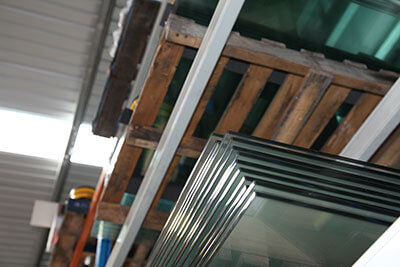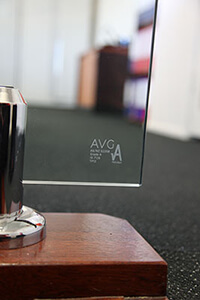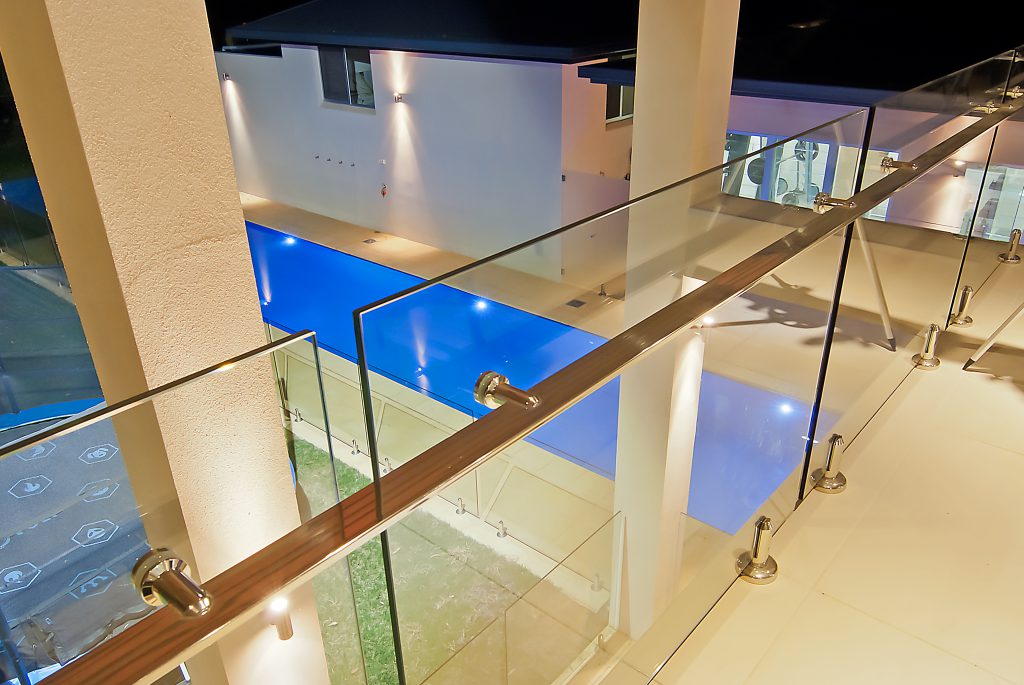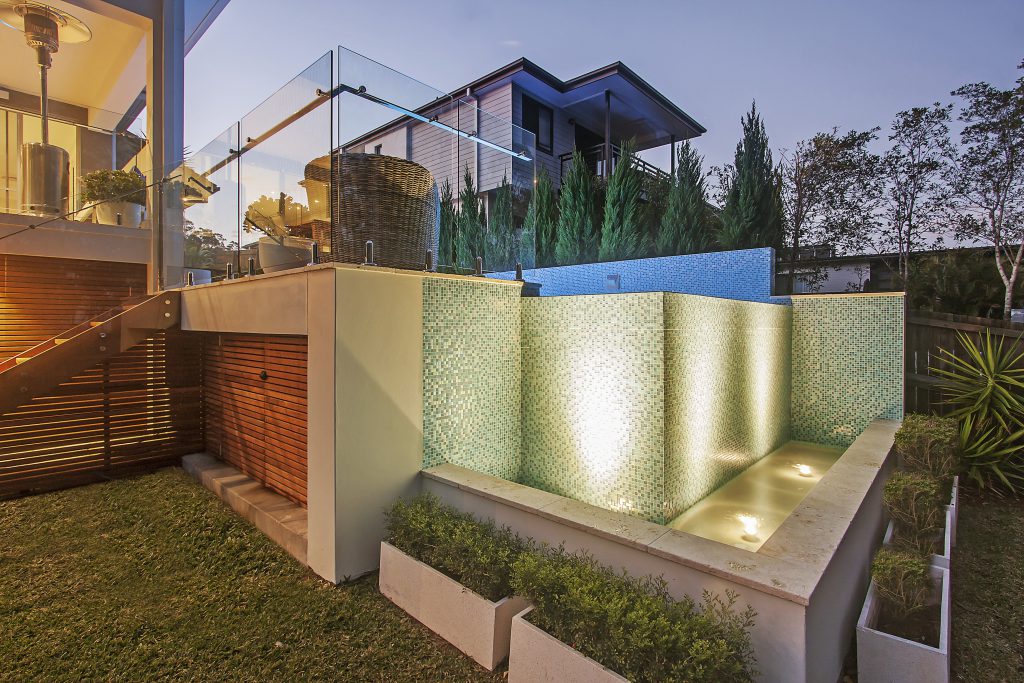At Aqua Vista Glass all our products are Grade A toughened safety glass. All glass begins the manufacture process as float glass.
How is float glass manufactured?
The twentieth century saw improvements in the method of glass manufacture through better optical quality and larger panels. Nevertheless, these improvements still produced glass with slightly uneven or distorted surfaces.
In order to improve the optical qualities, both surfaces were sometimes required to be ground and polished to achieve greater flatness and no distortion.
In 1952, Pilkington Glass invented the ‘Float process’ which revolutionised glass manufacture. The process ensured high optical quality, flatness and no distortion.
The float glass process is the most common method of flat glass production in the world. This process involves pouring the raw products of recycled glass, silica sand, limestone and soda ash from a furnace onto a large bed of molten tin, along with recycled glass.
The raw materials are then fed into a melting furnace where they are heated to around 1700C. The molten glass floats on top of molten tin in a float bath.

The temperature is then decreased to around 1100C and the hardening glass floats out of the tin bath into the annealing chamber until the temperature falls to around 700C. From the annealing chamber the glass is then cut into the required sheet sizes.
This mixture slowly solidifies over the molten tin as it enters the annealing oven where it travels along rollers under a controlled cooling process. From this point the glass emerges in one continuous long ribbon where it is then cut and further processed to customer specification.
Float glass has a green tinge from the iron within the glass and it is transparent when viewed face on.
Float glass offers a very high level of natural daylight or visible light transmittance to pass through it.
Due to the flat surface of the liquid tin, the float process creates exceptionally flat glass sheets, absolutely free from distortion. The float line process is a 24 hour a day non-stop operation. A float line can be operated continuously for periods of around 10 years without repair or refit.
What is Toughened and Heat Treated Glass?
All glass installed by Aqua Vista Glass is toughened and heat treated. Producing toughened and heat strengthened glass begins with the feeding by conveyor of cut-to-size annealed sheets of glass (with minimum arrised edges) into a furnace.
The glass oscillates back and forth on ceramic rollers to an approximate temperature of 620C.
Under computer control, the glass moves into the quench where it is rapidly cooled by high pressure cool air.
This ‘snap’ cooling or quenching induces compressive stresses to the glass surface, while the centre remains in tension.
Although the physical characteristics remain unchanged, the additional stresses created within the glass increases its strength by 4-5 times (for toughened glass) compared to that of annealed glass of equal thickness.
Toughened safety glass produced for Aqua Vista Glass is manufactured to the requirements of Australian Standard, AS/NZS2208.
Why Use Toughened Glass?
- It’s safer – Toughened safety glass used by Aqua Vista Glass is manufactured to Australian Standard AS/NZS2208 and 2080 and is a Grade A safety glass as per AS1288;
- It’s stronger – Up to 500% stronger than annealed glass and therefore is more resistant to thermal breakage and can withstand greater windloads. Toughened glass can be used within a temperature range of minus 70C to plus 250C (surface temperature should not exceed 250C if other surface is lower than 0C ambient);
- Suited to Frameless – Allows reduction of framing members to produce a cleaner frameless look;
- Ease of handling – Standard arrised edge makes handling easier and safer.
- Matching – Ease of matching tinted toughened Safety Grade A glass and tinted annealed glass.
- Variety of Thicknesses – Standard range includes 8-12mm Grade A Toughened Safety Glass. Between 4mm and 19mm thicknesses are available on custom order.
- Multiple Applications – Recommended for Semi Frameless Pool Fencing, Frameless Pool Fencing, Semi Frameless Glass Balustrade and Frameless Balustrade.

Why do Spontaneous Breakages occur?
On rare occasions, toughened glass can break for what seems to be no apparent reason. A variety of contaminants in the raw stock can lead to problems either during or subsequent to the toughening process. Investigation into some instances of spontaneous breakage has identified an impurity in the glass called nickel sulphide or NSI (Nickel Sulphide Inclusion) as the cause.
Microscopic nickel sulphide stones are a rare, undetectable contaminant in raw glass stock. The heating and rapid surface cooling processes of glass toughening is believed to change nickel sulphide stones from a stable to unstable state. Heat soaking is a method used to lower the chances of spontaneous breakage.
Most often however, breakage is usually due to surface damage or excessive loading on toughened glass.
Technical Information
- Surface treatments – Toughened glass cannot be drilled or edgeworked in any manner. Sand blasting and other surface treatments should be carried out prior to toughening. Deep sand blasted patterns greater than 1mm are not permissible.
- Minimum edgework – Finish on toughened glass up to 12mm is a standard arrised edge. Minimum edge work on greater thicknesses will be a flat ground edge;
- Bowing – Slight distortion or bowing may occur after toughening but is largely controllable. It will vary with substance, tint, surface treatment, size and shape of the glass. Ceramic painted, sand blasted or reflective coated glass has a greater tendency to bow and special tolerances would be advised. Flatness will be measured when the glass is standing on edge with a straight edge placed along the full length of the panel and a wedge measurement taken at the centre position;
- Visual distortion – The furnacing of glass panels can produce slight corrugated distortion or roller waves. This visual effect is in the form of distortion bands 250-300mm apart. It is more noticeable in tinted and reflective toughened glass. It is recommended that the roller wave run horizontal on the glass subject to the sizing constraints of the toughening furnace.
- Quench pattern – During the quenching phase of the toughening process, the glass is rapidly cooled by high velocity blasts of air. Inevitably this results in slightly higher levels of compression at those areas adjacent to the air nozzles. The consequence of this is the occasional appearance of a strain pattern or iridescent spots or darkish shadows. This effect is referred to as the quench pattern as it occurs in the furnace quench. Typically, the pattern is only visible at times of polarised light (polarised sunglasses) or by viewing the glass from the inside at acute angles. Similarly, the thicker and more reflective the glass, the more obvious the pattern will be;
Heat Soaking
Heat soaking involves heating toughened glass in a special oven at temperatures close to 280C to 290C for several hours to induce breakages that may be caused by inclusions or contaminants in the glass. However heat soaking does not guarantee detection of all inclusions or contaminants that may lead to spontaneous breakages.
Toughened Identification Stamp
Permanent stamps are located in the corner to identify the Australia Standards compliance license number.


